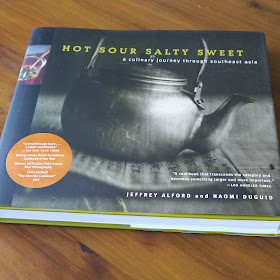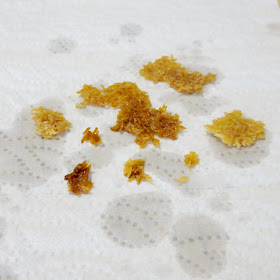The Setting: A day far too pretty not to be enjoyed outdoors.
The Soundtrack: Disney radio on Pandora.
Steaming up the oven: Nothing right now, but I'm contemplating cookies....
The Scenario: Last night's cooking class was outstanding!
Yesterday Hoosband and I had the privilege of celebrating Earth Day making French tarts, featuring farmer's market finds and the bounties of spring.
I completely regret not getting any action shots of the class, but it was a great group and a great time.
For something on the savory side, we made Asparagus, Leek, and Goat Cheese Tarts with a simple side salad of baby arugula in an Orange-Balsamic Vinaigrette.
Since we only used the tops of the asparagus spears for our tarts and we discarded the overly woody ends, the asparagus "middles" were tossed with a little balsamic vinegar, olive oil, salt, and pepper; roasted; and wrapped by bundles of three in paper-thin sheets of prosciutto--the perfect appetizer to munch on as we baked.
For dessert, delicious Vegan Berry Tarts surprised the class with a tofu-based filling every bit as good as traditional French pastry cream.
Our vegan tart dough was a little crumbly (turns out I left 2 of the 4 T of tofu out of the dough...sorry y'all!), but we churned out perfect little tart shells nonetheless.
Thanks so much to everyone who came to the class. I hope you enjoyed it as much as I did!
Orange-Balsamic Vinaigrette
These measurements are approximate. I usually just wing it and taste it with a leaf of arugula to make sure it's how I want it before tossing it with the rest of the leaves.
1 T orange marmalade or leftover glaze from Vegan Berry Tarts (I used Smuckers)
1 tsp kosher salt
1/2 tsp freshly cracked black pepper
1/2 cup balsamic vinegar
1/4 cup olive oil
Whisk all ingredients together in a large bowl until smooth, add greens of choice (I prefer baby arugula), and toss gently to coat.
Asparagus, Leek, and Goat Cheese Tarts
This recipe looks really long and intimidating, but it is much easier than you think!
~for the crust~
1 1/2 sticks cold unsalted butter
3-6 T cold water
1 2/3 cups whole wheat pastry flour (I used Bob's Red Mill)
1 tsp sugar
1 tsp kosher salt (or 1/2 tsp fine-grain salt)
~for the filling~
8 oz fresh goat cheese
2 large eggs
1-2 T butter
3 leeks
freshly cracked black pepper, to taste
1 1/2 tsp kosher salt (3/4 tsp if using fine-grain), divided
2 cups washed and rinsed asparagus tops, or as much as desired, for topping*
Cut the butter into 1/2-inch cubes, and place in the freezer (for at least 5 minutes) until needed. Place the water in the freezer in a small cup or bowl.
Place a large piece of parchment paper or plastic wrap on your counter.
Fit a large-basined food processor with the dough blade and add the flour, sugar, and salt. Pulse a few times to combine (if doing this by hand, whisk dry ingredients together in a medium-sized bowl).
Add the butter from the freezer to the processor and pulse until the mixture looks like coarse sand, with the largest pieces roughly the size of peas (if doing this by hand, use two forks to cut the butter into the flour, ideally striving to attach butter to every grain of flour without melting the fat).
With the processor on, add 1 T of ice water at a time just until the dough starts to comes together and holds together well when a small bit is squeezed with your fingers (if doing this by hand, continue to use the forks, or switch to a wooden spoon or silicone spoonula).
Turn the dough out onto the parchment or plastic, gently form into a disk, handling minimally, and wrap up tightly in the parchment or plastic. Let chill in the fridge for at least 1 hour or up to 8 (you can freeze the dough at this point if making ahead, but just be sure to thaw in the fridge overnight before using).
Preheat the oven to 350 degrees F, and line 20 standard-sized muffin cups with muffin liners--do not grease.
Roll out the dough between two sheets of parchment paper to a 1/8-1/4-inch thickness (just a little thinner than what you see below).
Use a 3-inch round cookie cutter or jar lid to cut out as many circles as you can, re-rolling dough as necessary (you should end up with 20 circles and a tiny nugget of scrap dough).
Carefully fit each circle into a prepared muffin cup. Poke the bottom of each shell all over with the tines of a fork, and bake at 350 degrees F for 20 minutes or until cooked through but still pale-ish in color. Place on cooling racks and allow to cool completely. Increase oven temp to 375.
To make the filling, set the goat cheese and eggs out at room temperature while you prepare the leeks.
Thinly slice the white and very light green parts of the leeks and rinse very well in cool water to remove any grit. If your leeks look dirty, it may be necessary to set them in a strainer in a large bowl of cold water and let them soak for 5-10 minutes. Discard the darker green parts of the leeks.
Place the rinsed leeks, butter, and black pepper in a large saute pan over med-high heat. Cover and cook 10 minutes. The leeks should be just beginning to blacken in parts along the bottom of the pan--don't worry, this is what you want. Stir in 1/2 tsp kosher salt, reduce heat to low, cover, and cook 10 minutes more. Remove from heat, partially uncover, and allow to cool.
Beat together the goat cheese, eggs, and remaining kosher salt until smooth and creamy. Add the leeks and beat just to incorporate.
Spoon the leek mixture into each prepared tart shell so that it fills the basin and covers the top edges.
Stick 1-3 asparagus tops into the centers of each tart, or decorate as desired.
Bake at 375 degrees F for 25 minutes or till cooked through and very lightly golden on top.
Finish with a sprinkle of coarse black pepper, if desired. Serve warm, room temperature, or cold. Store leftovers in an airtight container in the fridge for up to one week.
*To do the swirly design seen in the first photo, use a mandolin to thinly slice long, fettuccine-like strips of blanched asparagus; tightly roll up one strip at a time, and immediately press into the filling. continue until you have achieved your desired design. I also tried simply mounding up the asparagus ribbons on top of the tarts, but this was rather unpleasant to consume.


.JPG)
.JPG)


.JPG)

.JPG)






.JPG)


.jpg)













.JPG)
.JPG)
.JPG)
.JPG)
.JPG)
.JPG)






.JPG)

.JPG)
.JPG)
.JPG)
morgan+crumm.JPG)
.JPG)